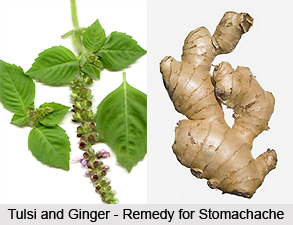 Vomitting, Cholera, Indigation etc, are coming under Diseases of the digestive system and can be easily treated through Tulsi.
Vomitting, Cholera, Indigation etc, are coming under Diseases of the digestive system and can be easily treated through Tulsi.
•Vomiting caused by excess bile subsides by drinking a mix of ten gms of Tulsi juice, ten gms of ginger juice and 20 gms of lemon juice sweetened with powedered sugar.
•Vomiting due to vata, pitta and kapha can be cured by drinking Tulsi juice to which powdered cardamom seeds have been added.
•Vomiting and lack of appetite are cured by taking a mixture of powdered peepar (piper longum) and powdered Tulsi seeds with honey.
•Vomiting of all types subsides on taking Tulsi juice with honey.
•To cure vomiting caused by fever drink a mixture of 10 gms of Tulsi juice and 25 gms of water sweetened with 10 gms of sugar.
•Drinking 25 gms of mixed juice of Tulsi leaves, leaves of the drumstick tree with a little saindhav salt stimulate digestion and induce regular bowel motion.
•Take ten gms of each dried Tulsi leaves, seeds of large cardamoms, cumin seeds, dry ginger, cinnamon, ajwan seeds, black salt and roasted asafoetida. Powder and sieve it. This powder with water stimulates digestion.
•Ingestion of Tulsi leaves and powdered black pepper cures dyspepsia.
•Licking equal quantities of powdered Tulsi seeds and powdered peepar (piper longum) with honey will stimulate appetite.
•Take equal quantities of the roots of the Tulsi plant and the stones of the fruits of the neem tree. Grind these together and prepare pea-sized pills out of the resulting paste. Two of these pills taken with honey every morning and evening will cure piles. The pills can be taken with buttermilk instead of honey.
•For piles sores drinking the juice of Tulsi leaves and the roots of kakjangha (a run), and apply the juice on the sores.
•If there is a burning sensation in the chest, the stomach or the calves, application of a paste of Tulsi leaves mixed with a paste obtained by a piece of deodar wood gives relief.
•Drinking the above decoction after adding threee gms of powdered nutmeg brings rapid relief even in difficult cases of irregularity in bowel motions.
•Take equal quantities of Tulsi leaves, mandar roots and black pepper. Grind these ingredients together and roll into pills. These pills constitute an effective remedy for cholera.
•Another treatment for dysentery is administration of dried Tulsi leaves with cumin seeds and black, salt in curds, or mattha.
•For diarrhoea with blood drink a mixture of soaked ten gms of Tulsi seeds in 50 gms of water overnight. Grind them, strain and drink with milk or water.
•For watery stools a mix of Tulsi leaves and the bark of the indrajav plant works wonders.
•Diarrhoea due to inefficient digestion is cured by an extract of Tulsi leaves, with saunf (fenel seeds) powder, fried in ghee and sugar.
•Spoonful of Tulsi juice mixed with a spoonful turmeric juice three times a day is beneficial in any disorder of the digestive system.
•If suffering from recurring stomach ulcers drink a decoction of Tulsi leaves and the leafy part of the soya (soya, dill) plant, and little saindhav salt.
•Enlargement of the spleen can be cured by taking five gms of mixed Tulsi roots, salammoniac, borax (the dehydrated form), and javakhar (yavakshar).
•Drinking a warm mixture of Tulsi and ginger juice cures stomachache.
•Chewing Tulsi leaves with a little sugar is a good remedy for colic.
•Five gms of powdered Tulsi leaves, five gms of roasted cumin seeds, five gms of bili (bilwa) powder and two gms of black salt added to 50 gms of curds, and mixed well. This mixture is beneficial in dysentery, colic, grips and inefficient digestion.
•Boil ten gms of Tulsi leaves in 100 gms of water, till only half the water is left, and strain the extract. Drinking this extract will arrest the enlargement of the liver, and cure allied disorders.
•Applying a paste of ground Tulsi leaves will cure inflammations.
•Drinking an extract of Tulsi seeds and sona mukhi leaves cures obstruction in the urinary tract and the rectum.
•To cure tumours apply a paste of ground Tulsi seeds, white sarasao (sara son), radish seeds, drumstick seeds, barley `and the roots of kaner.
•Hiccups can be cured by taking a teaspoonful of Tulsi juice and half a spoonful of honey in the morning and evening.
•Prepare an extract of Tulsi leaves and its inflorescences. Mix with jaggery and take it regularly to cure hiccups.



















